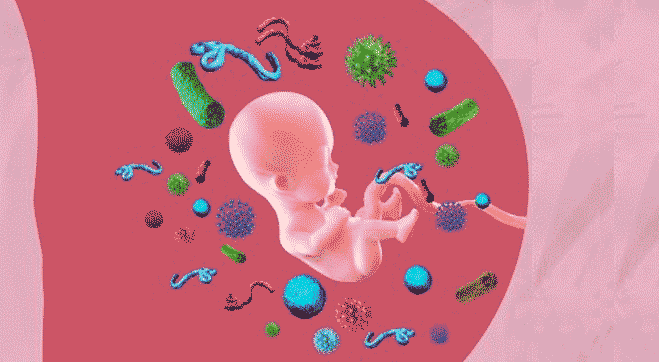A piece of soul is entrusted to the child, when a mother conceives a boon of life… She imbibes the unconditional love, protects her fetus from troubles around… Despite all the protection, some infections still creep in, unknowingly from mother to the child…
Vertical infections are the type of infections that are transmitted from the mother to child. They are transferred at different stages like in the womb, around the time of birth by exposure to blood and secretions, and after birth exposure via breastfeeding. These infections can have adverse effects on the health of fetus and newborn. While, the common and severe vertically transmitted infections are TORCH, HIV and hepatitis B, infections with group B Streptococcus, E.coli, enterovirus and adenovirus can also be passed on to the child.
- TORCH
TORCH complex is a cluster of infections that include Toxoplasmosis, other infections (Syphilis,
varicella-zoster virus and other infectious diseases), Rubella, Cytomegalovirus, and Herpes Simplex Virus. TORCH infections are mostly prevalent in the low-income and middle-income countries.
- Toxoplasmosis
A parasitic infection caused by the protozoa, Toxoplasma gondii on consumption of infected, uncooked meat or coming in contact with soil contaminated with cat feces, as cats are the preferred definitive host of the parasite. A pregnant women who has come in contact with the pathogen can transfer it to her fetus, and this has detrimental effects causing life threatening diseases like encephalitis and myocarditis in the developing fetus. Such an infection during pregnancy can cause miscarriage, still birth and brain damage in the fetus.
- Other Infections
Syphilis is a sexually transmitted disease caused by the spirochete Treponema pallidum and is passed on from mother to the fetus at any stage of pregnancy. Adverse effects of syphilis include perinatal death, preterm birth, low birth weight, congenital abnormalities, active syphilis in the newborn (NB), deafness and neurological impairment.
- Rubella
Is a virus that causes German measles, characterized by the development of rashes and is generally mild in children. However, in pregnant women it may have serious consequences leading to fetal death or defects known as congenital rubella syndrome (CRS). If contracted early in pregnancy, it can also cause growth retardation, hearing loss, blood disorders and pneumonia in the unborn child. It is an air borne viral infection that has no treatment but can be prevented by vaccination.
- Cytomegalovirus
It belongs to the family of herpes viruses, which spreads through direct contact with body fluids, and hence can spread to the fetus through breastfeeding. Infections are characterized by premature birth, small body and head size, seizures as well as long term health problems like vision and hearing loss, lack of concentration, and muscle weakness.
- Herpes Simplex Virus
HSV is contracted usually during delivery when the baby passes through the birth canal, via the placenta or from other infected persons in the hospital. Severely infected newborns develop fluid-filled blisters (bumps) on the skin, lesions in the mouth area, inflammation of the mucous membrane lining the eyelids and whites of the eyes (conjunctivitis), inflammation of the liver (Hepatitis), and difficulties in breathing
- TORCH Screening
the TORCH test detects the presence of infection by these set of organisms and the quantity of IgG and IgM antibodies in the serum, that has been synthesized against a particular infection. Maternal IgM group of antibodies are not passed on to fetus through placenta hence, presence of IgM antibodies against any of the TORCH pathogen, in the fetus indicates congenital infection. Contrary to this, observation of IgG antibodies indicates maternal origin.
- HIV and Hepatitis B Virus (HBV)
Human Immunodeficiency Virus (HIV) causes Acquired immunodeficiency syndrome (AIDS) which affects approximately 36.7 million people worldwide, out of which 2.1 million are children (<15 years). About 65% of HIV-infections in the infants are estimated to be transmitted during labor. HBV is a DNA virus affecting liver and indicates chronicity of about 90% in infants infected at birth or during the first year of life. These viruses are transmitted transplacentally, during delivery and post delivery
In absence of preventive measures, 15-45% HIV transmission is accounted which can be reduced to below 5% with effective implementations during pregnancy, labour, delivery and breastfeeding. As infants are yet to develop their immune system, HIV infection rapidly progresses to AIDS, increasing the chances of contracting opportunistic diseases causing morbidity and mortality.
In case of HBV, transplacental transmission is the most common mode. Age of acquiring the infection is said to be inversely proportional to the risk of chronic infection. It has been associated with higher incidences of low birth weight and preterm birth during acute infection. Whilst gestational Diabetes mellitus, antepartum hemorrhage and preterm delivery are observed during chronic maternal HBV infections.
- HIV and HBV Screening
Qualitative detection of HIV can be done by ELISA for HIV-1 & ll and Western blot using Paper Chromatography whereas, Quantitative estimation of viral load is done by using RT-PCR.
Presence of Hepatitis B surface antigen (HBsAg) is considered as the first serological marker in diagnosing HBV infection. Positivity of HBsAg in around 6 months after birth, indicates infection in the newborn. Antibodies generated against the envelope antigen (HBeAg) and core antigen (HBcAg) are passed through placenta and disappear around the age of 12-24 months in nearly all babies.
Screening for HIV and HBV in pregnant women, and prophylaxis with specific antiretroviral therapy (ART) and anti-HBV antibodies respectively at birth, and vaccination for newborns of HBV infected mothers are some of the effective measures taken to reduce the risk of this vertical infection transmission
With every singe day, a life is formed with every thing that a mother provides; till finally a child is born. From bearing the child to their nourishment, love, and care she transmits her likes, dislikes, appearance and many more. But along with the goodness of desired traits are some reluctant woes that are transmitted along this connection of life. Screening for these infections is the apt shield to avoid the untoward from happening.








